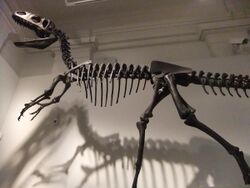Biology:Neovenatoridae
| Neovenatorids | |
|---|---|

| |
| Restoration of Neovenator salerii | |
| Scientific classification | |
| Domain: | Eukaryota |
| Kingdom: | Animalia |
| Phylum: | Chordata |
| Clade: | Dinosauria |
| Clade: | Saurischia |
| Clade: | Theropoda |
| Clade: | †Carcharodontosauria |
| Family: | †Neovenatoridae Benson, Carrano & Brusatte, 2010 |
| Type species | |
| †Neovenator salerii Hutt, Martill, & Barker, 1996
| |
| Subgroups | |
| |
Neovenatoridae is a proposed clade of carcharodontosaurian dinosaurs uniting some primitive members of the group such as Neovenator with the Megaraptora, a group of theropods with controversial affinities. Other studies recover megaraptorans as basal coelurosaurs unrelated to carcharodontosaurs. Other theropods with uncertain affinities such as Gualicho, Chilantaisaurus and Deltadromeus are also sometimes included.
Classification
Phylogenetic studies conducted by Benson, Carrano and Brusatte (2010) and Carrano, Benson and Sampson (2012) recovered the group Megaraptora as members of the Neovenatoridae. This would make neovenatorids the latest-surviving allosauroids; at least one megaraptoran, Orkoraptor, lived near the end of the Mesozoic era, dating to the early Maastrichtian stage of the latest Cretaceous period, about 70 million years ago.[1][2] On the other hand, Novas et al. (2012), while confirming that Neovenator was closely related to carcharodontosaurids, simultaneously found Megaraptor and related genera to be coelurosaurs closely related to tyrannosaurids.[3] However, Novas et al. subsequently found that megaraptorans lacked most of the key features in the hands of derived coelurosaurs including Guanlong and Deinonychus. Instead, their hands retain a number of primitive characteristics seen in basal tetanurans such as Allosaurus. Nevertheless, there are still a number of other traits that support megaraptorans as members of the Coelurosauria.[4]
The cladogram below follows a 2016 analysis by Sebastián Apesteguía, Nathan D. Smith, Rubén Juarez Valieri, and Peter J. Makovicky based on the dataset of Carrano et al. (2012).[5]
| Allosauroidea |
| ||||||||||||||||||||||||||||||||||||||||||
References
- ↑ Benson, R.B.J.; Carrano, M.T; Brusatte, S.L. (2010). "A new clade of archaic large-bodied predatory dinosaurs (Theropoda: Allosauroidea) that survived to the latest Mesozoic". Naturwissenschaften 97 (1): 71–78. doi:10.1007/s00114-009-0614-x. PMID 19826771. Bibcode: 2010NW.....97...71B.
- ↑ Matthew T. Carrano, Roger B. J. Benson and Scott D. Sampson (2012). "The phylogeny of Tetanurae (Dinosauria: Theropoda)". Journal of Systematic Palaeontology 10 (2): 211–300. doi:10.1080/14772019.2011.630927.
- ↑ F. E. Novas; F. L. Agnolín; M. D. Ezcurra; J. I. Canale; J. D. Porfiri (2012). "Megaraptorans as members of an unexpected evolutionary radiation of tyrant-reptiles in Gondwana". Ameghiniana 49 (Suppl): R33. http://www.ameghiniana.org.ar/index.php/ameghiniana/article/view/868/1618.
- ↑ Novas, F.E.; Rolando, A.M.A.; Agnolin, F.L. (2016). "Phylogenetic relationships of the Cretaceous Gondwanan theropods Megaraptor and Australovenator: the evidence afforded by their manual anatomy.". Memoirs of Museum Victoria 74: 49–61. doi:10.24199/j.mmv.2016.74.05. https://museumvictoria.com.au/pages/381424/049-061_MMV74_Novas_4_WEB.pdf.
- ↑ Sebastián Apesteguía; Nathan D. Smith; Rubén Juárez Valieri; Peter J. Makovicky (2016). "An Unusual New Theropod with a Didactyl Manus from the Upper Cretaceous of Patagonia, Argentina". PLOS ONE 11 (7): e0157793. doi:10.1371/journal.pone.0157793. PMID 27410683. Bibcode: 2016PLoSO..1157793A.
Wikidata ☰ Q133002 entry
 |


